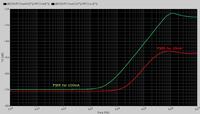ashish_chauhan
Full Member level 5
congrats dear you have done it!!
but did u notice the difference between two values of psrr at dc freqs ...
I asked u to run sim for 100mA just for that ... this will provide u some insight in psr behaviour of ldo.
but did u notice the difference between two values of psrr at dc freqs ...
I asked u to run sim for 100mA just for that ... this will provide u some insight in psr behaviour of ldo.
